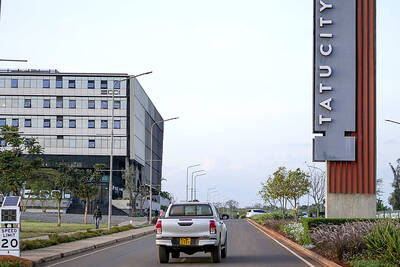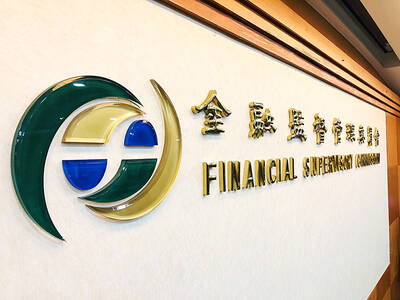Taiwan’s manufacturing sector remained sluggish for a second straight month last month due to an uneven recovery balancing strong high-tech players against a fragile old-economy sector, the Taiwan Institute of Economic Research (TIER) said yesterday.
The composite index assessing the manufacturing sector’s fundamentals fell 0.68 points from a month earlier to 11.20 last month, the lowest level since February, when the index stood at 10.41, data compiled by the think tank, showed.
Last month’s index fell into the “yellow-blue” range of 10.5 to 13, signaling a slowdown.

Photo: CNA
The TIER uses a five-color system to assess economic activity in the sector, with red indicating overheating, yellow-red showing fast growth, green representing stable growth, yellow-blue signaling sluggish growth and blue signifying contraction.
Among the five factors in last month’s index, the subindices for purchases of raw materials and pricing fell 0.67 and 0.38 respectively from a month earlier.
The subindices for the other three factors — general business climate, demand and costs — rose 0.22, 0.11 and 0.04 respectively from a month earlier, the TIER said.
Exports from the old economy sector limited the growth of Taiwan’s industrial production, which led to manufacturers scaling back purchases of raw materials as a whole during the month, it said.
Citing a survey conducted last month, the TIER said 44.21 percent of respondents in the manufacturing sector said their business flashed a blue light, up slightly from 43.17 percent in a similar poll in September.
Another 26.25 percent of them said their operations flashed a yellow-blue light last month, up from 19.63 percent a month earlier, and 25.43 percent said their business flashed a green light, up from 23.76 percent in September.
The electronic component sector continued to benefit from robust global demand for artificial intelligence (AI) applications and high performance computing (HPC) devices, which pushed up exports of semiconductors to the US, ASEAN countries and India last month, the TIER said.
However, electronics component exports to Japan, China and Europe weakened last month, offsetting the strength in the entire sector, resulting in a green light, the TIER said.
On the other hand, the base metal sector flashed a yellow-blue light last month, as demand in the global steel market remained flat and low-priced steel products sent ripples through the market, the TIER said.
However, demand for stainless steel and select refined copper items from US and European markets gave some support to the industry.
The TIER said US president-elect Donald Trump is expected to influence the global economy when he returns to the White House in January, especially if he carries out threats to impose 25 percent tariffs on goods from Canada and Mexico and raise tariffs on imports from China by 10 percent.
Trump’s proposed tariff hikes and a plan to deport illegal immigrants are expected to boost inflationary pressures and in turn affect the US Federal Reserve’s monetary policies, which could affect demand and Taiwan’s export- oriented manufacturing sector, the institute said.

To many, Tatu City on the outskirts of Nairobi looks like a success. The first city entirely built by a private company to be operational in east Africa, with about 25,000 people living and working there, it accounts for about two-thirds of all foreign investment in Kenya. Its low-tax status has attracted more than 100 businesses including Heineken, coffee brand Dormans, and the biggest call-center and cold-chain transport firms in the region. However, to some local politicians, Tatu City has looked more like a target for extortion. A parade of governors have demanded land worth millions of dollars in exchange

Hong Kong authorities ramped up sales of the local dollar as the greenback’s slide threatened the foreign-exchange peg. The Hong Kong Monetary Authority (HKMA) sold a record HK$60.5 billion (US$7.8 billion) of the city’s currency, according to an alert sent on its Bloomberg page yesterday in Asia, after it tested the upper end of its trading band. That added to the HK$56.1 billion of sales versus the greenback since Friday. The rapid intervention signals efforts from the city’s authorities to limit the local currency’s moves within its HK$7.75 to HK$7.85 per US dollar trading band. Heavy sales of the local dollar by

Taiwan Semiconductor Manufacturing Co’s (TSMC, 台積電) revenue jumped 48 percent last month, underscoring how electronics firms scrambled to acquire essential components before global tariffs took effect. The main chipmaker for Apple Inc and Nvidia Corp reported monthly sales of NT$349.6 billion (US$11.6 billion). That compares with the average analysts’ estimate for a 38 percent rise in second-quarter revenue. US President Donald Trump’s trade war is prompting economists to retool GDP forecasts worldwide, casting doubt over the outlook for everything from iPhone demand to computing and datacenter construction. However, TSMC — a barometer for global tech spending given its central role in the

The Financial Supervisory Commission (FSC) yesterday met with some of the nation’s largest insurance companies as a skyrocketing New Taiwan dollar piles pressure on their hundreds of billions of dollars in US bond investments. The commission has asked some life insurance firms, among the biggest Asian holders of US debt, to discuss how the rapidly strengthening NT dollar has impacted their operations, people familiar with the matter said. The meeting took place as the NT dollar jumped as much as 5 percent yesterday, its biggest intraday gain in more than three decades. The local currency surged as exporters rushed to